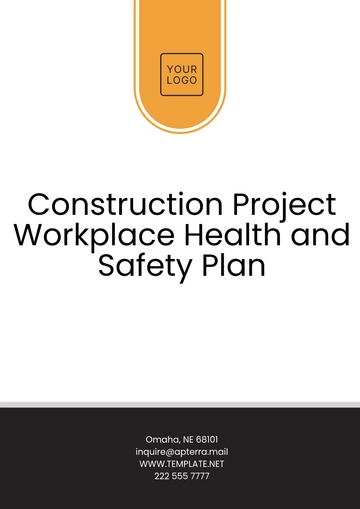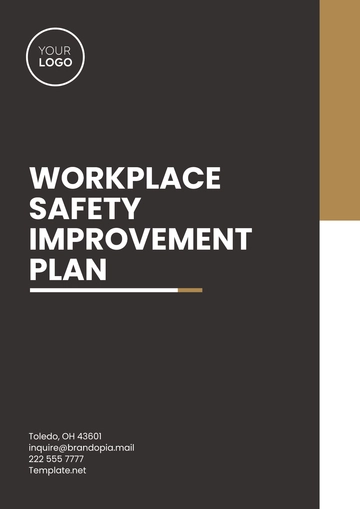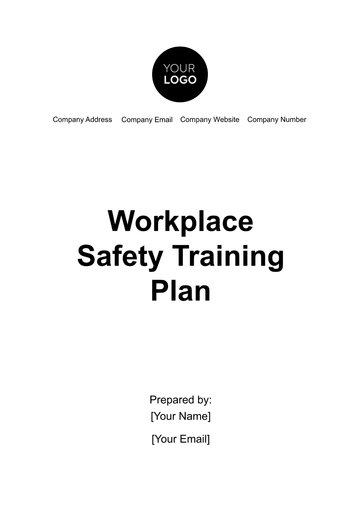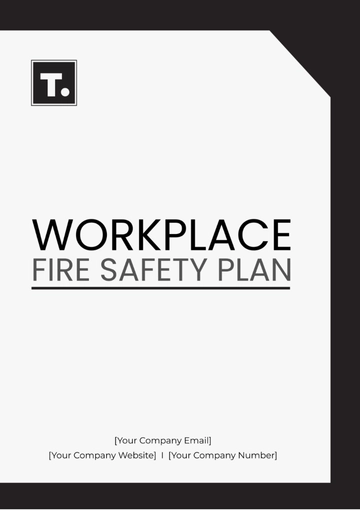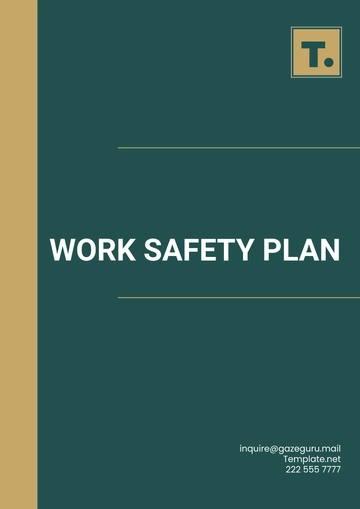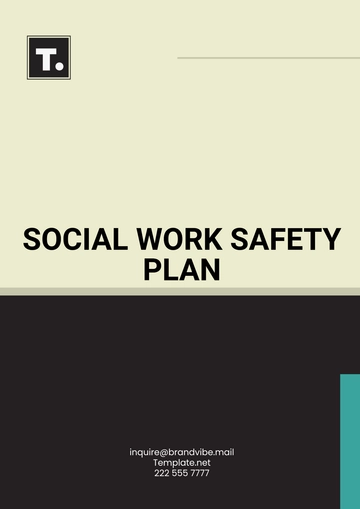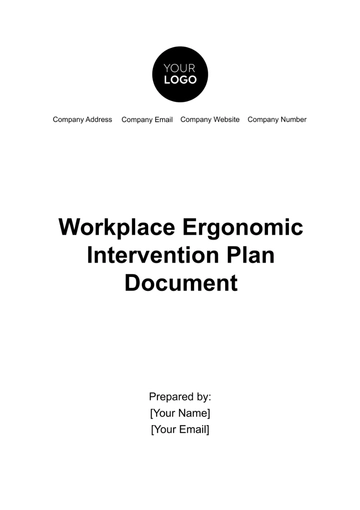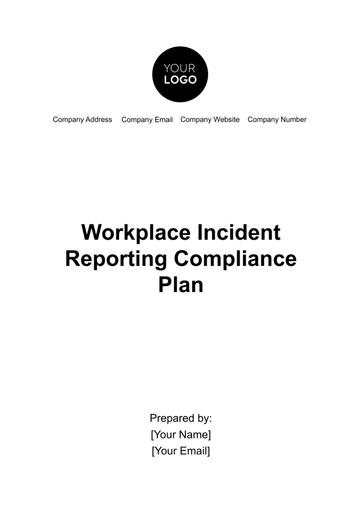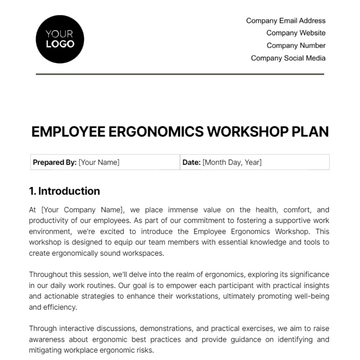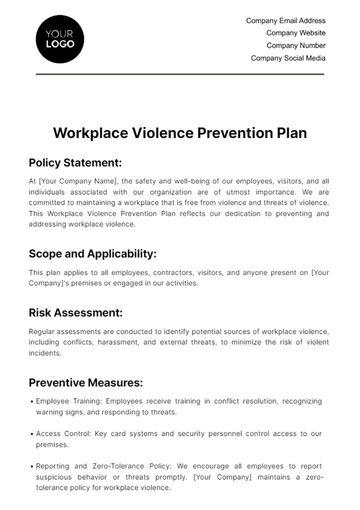Free Work Safety Plan
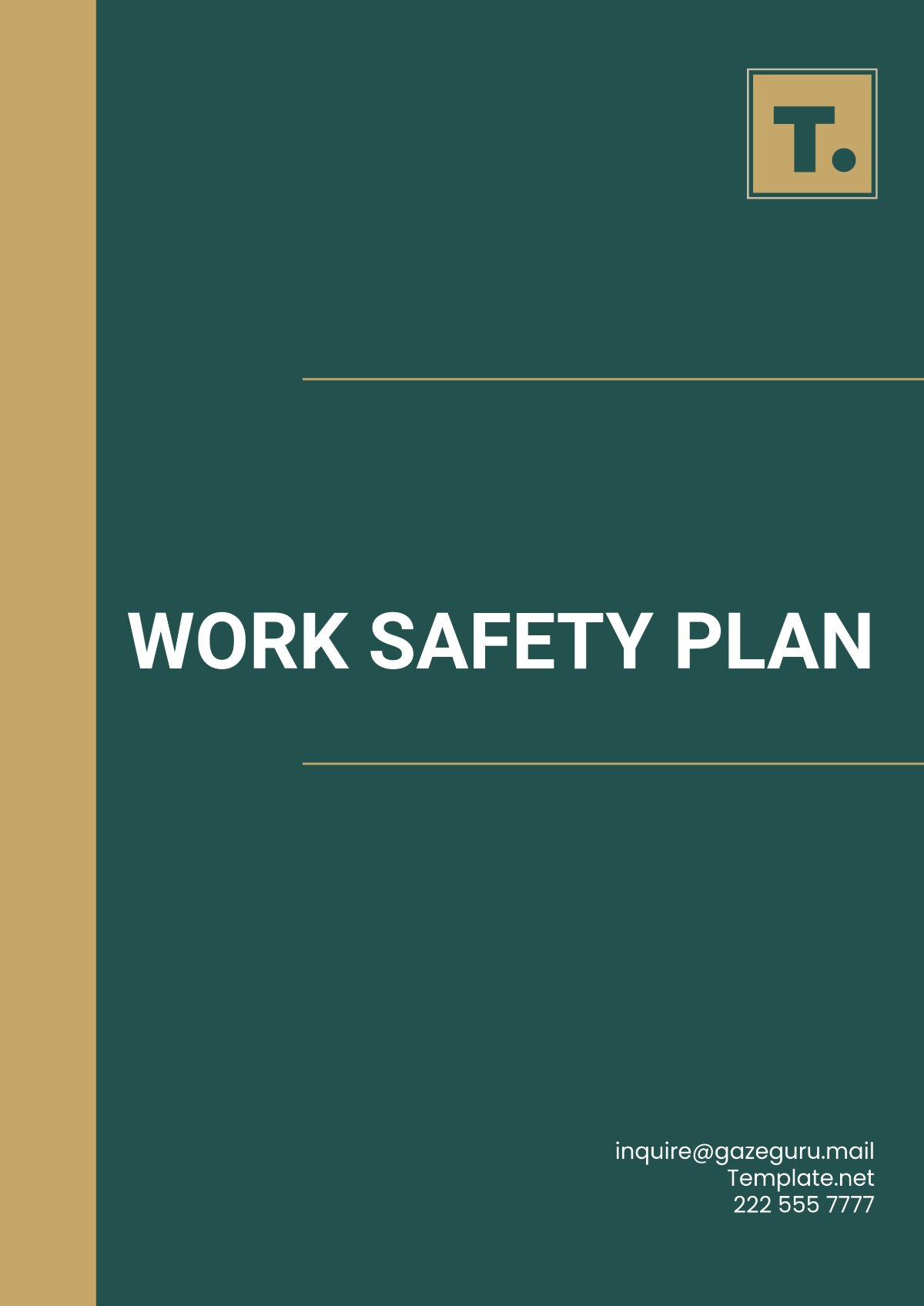
Prepared by: | [YOUR NAME] |
Company: | [YOUR COMPANY NAME] |
Department: | [YOUR DEPARTMENT] |
Date: | [DATE] |
I. Introduction
The fundamental aim of this Work Safety Plan is to strategically develop and diligently implement a comprehensive suite of safety protocols. These protocols are meticulously crafted to diminish risks associated with the workplace, ensure strict compliance with all relevant health and safety regulations, and foster an environment that prioritizes the security and well-being of all employees at [YOUR COMPANY NAME]. This initiative underscores our commitment to maintaining a safe and productive working environment.
II. Objectives
Identify potential workplace hazards: Identify and document all potential hazards in the workplace environment.
Develop appropriate risk assessments: Assess identified hazards to determine their level of risk and prioritize them for mitigation.
Implement safety training programs: Provide comprehensive safety training to all employees to ensure they understand safety protocols and procedures.
Outline emergency procedures: Develop and document clear procedures for responding to emergencies such as fires, medical incidents, or chemical spills.
Ensure protective and preventive measures are in place: Implement measures such as safety equipment, signage, and protocols to prevent accidents and injuries.
Enhance workplace safety awareness. Promote a safety culture through awareness, regular briefings, and active employee involvement in safety programs.
III. Risk Identification
A. Hazard Assessment
Inspection | Potential Hazards | Inspection Criteria |
|---|---|---|
Machinery Operation | Malfunctioning equipment, inadequate guarding | Check for signs of equipment wear, and inspect guards for completeness and proper installation. |
Chemical Storage | Improper labeling, inadequate containment | Ensure all containers are properly labeled according to safety standards, and check for leaks. |
Ergonomic Practices | Improper seating, repetitive motion hazards | Evaluate workstation setup for ergonomic design, and assess tasks for potential repetitive motion.ns |
B. Employee Feedback
Establish Dedicated Channels: Establish an easily accessible method for employees to report observed hazards, such as a specific email, an online form on the intranet, or a suggestion box in common areas.
Anonymity and Confidentiality: Ensure that employees feel comfortable reporting hazards by guaranteeing anonymity or confidentiality if desired. This promotes open communication and encourages reporting of even minor concerns.
Prompt Response: Establish protocols for promptly reviewing and addressing reported hazards. Acknowledge receipt of reports and communicate actions taken or planned to address the concerns raised.
IV. Risk Assessment
A. Risk Analysis
Likelihood of Occurrence: Assess the probability of each identified risk occurring in the workplace. Consider historical data, industry standards, and specific operational factors.
Potential Impact: Evaluate the potential consequences of each risk on employee safety, business operations, and company reputation. This includes assessing the severity of injuries, property damage, downtime, and regulatory penalties.
Prioritization: Combine likelihood and impact assessments to prioritize risks for mitigation efforts. Focus on high-likelihood risks with significant potential impact first, followed by lower-priority risks.
B. Documentation
Date: Record the date of each risk assessment to track the timing of evaluations and updates.
Identified Risks: Please provide a comprehensive list of all identified risks, accompanied by a concise description of each hazard associated with them.
Analysis: Document the results of risk analysis, including assessments of likelihood, impact, and prioritization criteria used.
Preventive Measures: Outline specific actions planned or already implemented to mitigate each identified risk. Include timelines and responsible parties for accountability.
Review and Updates: Schedule regular reviews of risk assessments to update information based on changes in operations, regulations, or incident reports.
V. Safety Training
A. Initial Training
Comprehensive Content: Cover essential safety protocols like fire safety, evacuation, PPE use, hazardous materials handling, and machinery safety.
Role-Specific Training: Tailor sessions to roles (forklift safety for warehouse, ergonomics for office).
Interactive Sessions: Use demos, simulations, and quizzes for engagement.
Documentation: Keep records of topics, materials, attendance, and evaluations.
B. Ongoing Training
Regular Schedule: Schedule regular refreshers based on turnover, regulations, and best practices.
Content Updates: Reflect protocol, regulation, and procedure changes in materials.
Legislative Compliance: Ensure employees know and follow legal safety requirements.
Feedback and Evaluation: Collect and act on feedback for continuous improvement.
VI. Emergency Procedures
A. Evacuation Plan
Clear Plan: Develop a detailed evacuation plan that includes evacuation routes, assembly points, and procedures for different types of emergencies (fire, chemical spills, etc.).
Employee Familiarity: Conduct regular evacuation drills to ensure all employees are familiar with the evacuation routes, assembly points, and emergency procedures.
Accessibility: Ensure that evacuation routes are clear and accessible at all times, and that signage is prominently displayed throughout the premises.
Communication: Establish communication protocols during emergencies, including methods for alerting employees and coordinating evacuations.
B. First Aid and Medical Emergency
First Aid Supplies: Keep first aid kits fully stocked and accessible in the workplace, and regularly replenish supplies.
Designated Staff: Train and equip selected staff in first aid, CPR, and emergency responses to manage medical emergencies until professional help arrives.
Emergency Contacts: Prominently post emergency contact information, including local services and company-specific response teams, in the workplace.
Documentation: Keep records of first aid training sessions, certifications, and inspections of first aid kits for compliance and accountability.
VII. Monitoring and Review
Continuous Monitoring: Implement regular checks and observations to ensure safety measures are being followed and are effective in mitigating risks.
Performance Metrics: Define key performance indicators (KPIs) such as incident rates, near-miss reports, and compliance levels to measure safety performance.
Regular Reviews: Conduct scheduled reviews of safety protocols, procedures, and training effectiveness. Use feedback from employees and incident reports to identify areas for improvement.
Adjustments: Make necessary adjustments to the safety plan based on review findings, operational changes, regulatory updates, and audit results.
VIII. Record Keeping
Training Records: Maintain detailed records of safety training sessions, including topics covered, attendance, evaluations, and certifications.
Incident Logs: Document all incidents, near misses, and accidents, including date, time, location, individuals involved, injuries, and corrective actions taken.
Compliance Checks: Keep records of compliance checks, inspections, audits, and corrective actions to ensure adherence to safety regulations and standards.
Reviews Documentation: Document the findings, recommendations, and actions from safety plan reviews for accountability and continuous improvement.
IX. Plan Approval
Management Approval: Ensure that the safety plan has been reviewed and approved by top management or relevant stakeholders before implementation.
Effective Date: Clearly state the effective date of the safety plan to indicate when it becomes enforceable.
Adherence: Communicate the importance of adherence to all departments and employees, emphasizing their role in maintaining a safe work environment.
- 100% Customizable, free editor
- Access 1 Million+ Templates, photo’s & graphics
- Download or share as a template
- Click and replace photos, graphics, text, backgrounds
- Resize, crop, AI write & more
- Access advanced editor
Ensure safety compliance with our Work Safety Plan Template from Template.net. This editable and customizable tool guarantees workplace safety adherence. Effortlessly personalize safety protocols, hazard assessments, and emergency procedures using our intuitive Ai Editor Tool. Empower your team to create a safe work environment by customizing policies and procedures to specific industry standards
You may also like
- Finance Plan
- Construction Plan
- Sales Plan
- Development Plan
- Career Plan
- Budget Plan
- HR Plan
- Education Plan
- Transition Plan
- Work Plan
- Training Plan
- Communication Plan
- Operation Plan
- Health And Safety Plan
- Strategy Plan
- Professional Development Plan
- Advertising Plan
- Risk Management Plan
- Restaurant Plan
- School Plan
- Nursing Home Patient Care Plan
- Nursing Care Plan
- Plan Event
- Startup Plan
- Social Media Plan
- Staffing Plan
- Annual Plan
- Content Plan
- Payment Plan
- Implementation Plan
- Hotel Plan
- Workout Plan
- Accounting Plan
- Campaign Plan
- Essay Plan
- 30 60 90 Day Plan
- Research Plan
- Recruitment Plan
- 90 Day Plan
- Quarterly Plan
- Emergency Plan
- 5 Year Plan
- Gym Plan
- Personal Plan
- IT and Software Plan
- Treatment Plan
- Real Estate Plan
- Law Firm Plan
- Healthcare Plan
- Improvement Plan
- Media Plan
- 5 Year Business Plan
- Learning Plan
- Marketing Campaign Plan
- Travel Agency Plan
- Cleaning Services Plan
- Interior Design Plan
- Performance Plan
- PR Plan
- Birth Plan
- Life Plan
- SEO Plan
- Disaster Recovery Plan
- Continuity Plan
- Launch Plan
- Legal Plan
- Behavior Plan
- Performance Improvement Plan
- Salon Plan
- Security Plan
- Security Management Plan
- Employee Development Plan
- Quality Plan
- Service Improvement Plan
- Growth Plan
- Incident Response Plan
- Basketball Plan
- Emergency Action Plan
- Product Launch Plan
- Spa Plan
- Employee Training Plan
- Data Analysis Plan
- Employee Action Plan
- Territory Plan
- Audit Plan
- Classroom Plan
- Activity Plan
- Parenting Plan
- Care Plan
- Project Execution Plan
- Exercise Plan
- Internship Plan
- Software Development Plan
- Continuous Improvement Plan
- Leave Plan
- 90 Day Sales Plan
- Advertising Agency Plan
- Employee Transition Plan
- Smart Action Plan
- Workplace Safety Plan
- Behavior Change Plan
- Contingency Plan
- Continuity of Operations Plan
- Health Plan
- Quality Control Plan
- Self Plan
- Sports Development Plan
- Change Management Plan
- Ecommerce Plan
- Personal Financial Plan
- Process Improvement Plan
- 30-60-90 Day Sales Plan
- Crisis Management Plan
- Engagement Plan
- Execution Plan
- Pandemic Plan
- Quality Assurance Plan
- Service Continuity Plan
- Agile Project Plan
- Fundraising Plan
- Job Transition Plan
- Asset Maintenance Plan
- Maintenance Plan
- Software Test Plan
- Staff Training and Development Plan
- 3 Year Plan
- Brand Activation Plan
- Release Plan
- Resource Plan
- Risk Mitigation Plan
- Teacher Plan
- 30 60 90 Day Plan for New Manager
- Food Safety Plan
- Food Truck Plan
- Hiring Plan
- Quality Management Plan
- Wellness Plan
- Behavior Intervention Plan
- Bonus Plan
- Investment Plan
- Maternity Leave Plan
- Pandemic Response Plan
- Succession Planning
- Coaching Plan
- Configuration Management Plan
- Remote Work Plan
- Self Care Plan
- Teaching Plan
- 100-Day Plan
- HACCP Plan
- Student Plan
- Sustainability Plan
- 30 60 90 Day Plan for Interview
- Access Plan
- Site Specific Safety Plan
